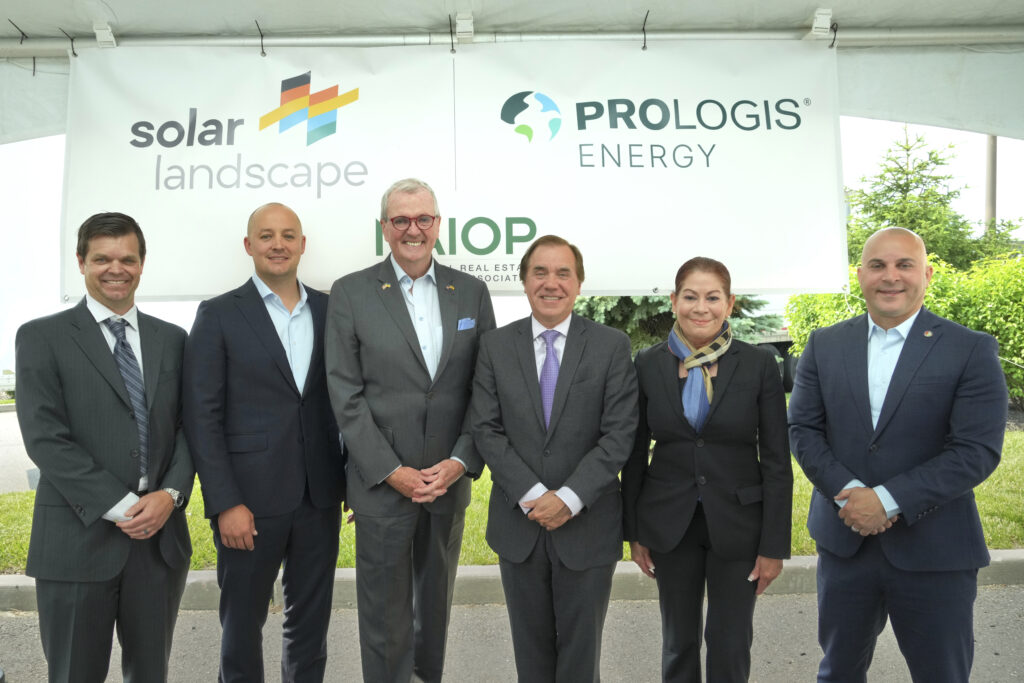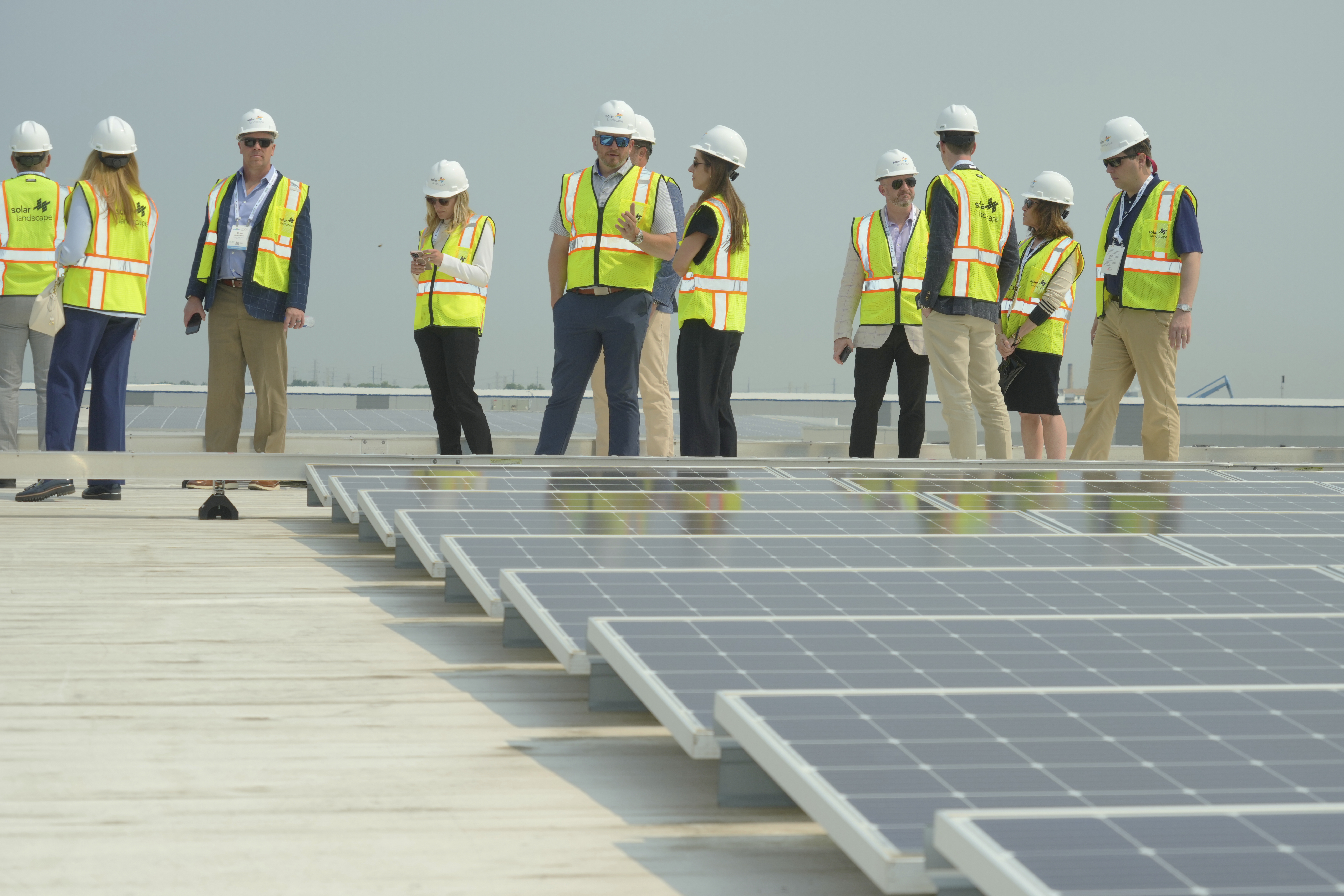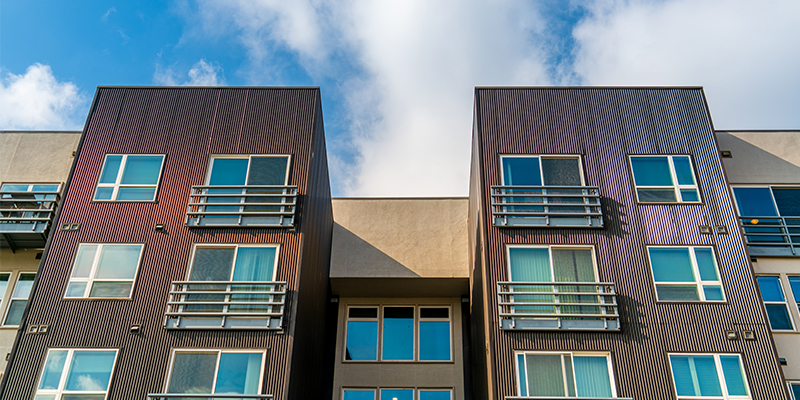By Marie Ruff
The U.S. is facing an energy crisis, with not enough power generated by the grid to feed the ever-growing demand. On Jan. 20, 2025, President Donald Trump declared this issue a national emergency. One effective solution to help address this expansive problem: transforming unused commercial rooftops into sources of solar power that can then be fed back into the energy grid.
During I.CON East, attendees had the opportunity to tour Prologis’ award-winning 2.7-megawatt solar installation in Perth Amboy, New Jersey. The tour was hosted by Solar Landscape, the largest commercial rooftop solar developer in the U.S. Together, the companies are working on nearly 70 rooftop projects in New Jersey, with more in development in Maryland and Pennsylvania.
Solar Landscape co-founder and CEO Shaun Keegan kicked off the event. The Prologis project, built in 2020, was the first in the state to do community solar. In this model, moderate- and low-income households in the area subscribe to receive solar power at a guaranteed discount – without needing to install anything in their own homes.
“With the support of everyone here today, New Jersey has emerged as one of the largest producers of solar energy in the entire northeast just last year, for the first time ever,” said New Jersey Governor Phil Murphy, a longtime champion of solar power. “We crossed five gigawatts of installed solar capacity – enough power to light up 750,000 homes.”
Community solar projects have several distinct benefits, the governor noted: they lower energy costs for people in the community; they are quick to set up and get online; and they create good-paying, primarily union jobs. “At the same time,” Murphy said, “[Community solar] accelerates our transition to cleaner, healthier and more sustainable energy in the future.”
“Everybody wins with community solar, and that’s not just good politics,” Murphy said. “It is a foolproof strategy for confronting one of the biggest challenges of our time, in addition to everything else I’ve just said, and that is combating climate change.”
“Together, we’re not only building a cleaner and more sustainable future for the Garden State,” Murphy said. “We’re carrying forward our proud legacy for pioneering innovations that create a better world for all of us. And what we’ve accomplished here in New Jersey and throughout our region is a model for our entire nation and indeed the world.”

New Jersey Assemblyman Craig Coughlin said that he has also come to believe that to meet the high demand for energy, the quickest, most cost-effective solution is solar.
“About 7% of our energy in the state comes from solar. We should increase that,” said Coughlin. “It’s a win-win for everybody,” from the environment to the developer to the community neighbors who are receiving the benefit of reduced energy payments.
“Now more than ever, we need to be thinking strategically and innovatively about energy production that meets our growing demand and provides options for taxpayers,” said New Jersey Assemblywoman Yvonne Lopez. “That’s why the model that Solar Landscape provides is so important because it meets our goal by delivering clean energy to residents while creating additional economic opportunities for the communities in which projects are located.”
“It’s a solar project, yes, but it’s also an investment. It’s a community investment that helps real people and [creates] a better future for the city of Perth Amboy,” said Perth Amboy Mayor Helmin J. Caba.
“Our rooftops represent one of the greatest untapped resources in commercial real estate, and this project proves how scalable and impactful they can be,” said Scott Peattie, Prologis vice president of commercial and industrial solutions (U.S.).
Tour attendees then climbed up to the rooftop to see solar power in action.

“Once the solar is properly installed, it extends the life of the roof because it keeps the insulation cool, keeps the membrane out of the elements, and keeps the sun from hitting the roof,” said Keegan. Solar panels typically last for 25-30 years, also roughly how long a roof is expected to last.
“Our company has a general rule of thumb that we don’t like to put solar on roofs that are older than about seven years old, but project development can take some time, so generally, if you have a roof that’s aging and you might replace it in the next three to four years, it’s a good idea to engage a solar developer to tee up the project so that when it’s time to reroof, you can roll out the solar.”
“Solar can be done the right way and the wrong way, and the industry is relatively young in the grand scheme of things,” Keegan said. “We’ve been at it for almost 15 years now, and the best practices have proven themselves out.”

Photo credit: Solar Landscape.

This post is brought to you by JLL, the social media and conference blog sponsor of NAIOP’s I.CON East 2025. Learn more about JLL at www.us.jll.com or www.jll.ca.








